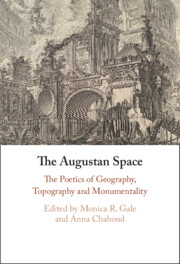Book contents
- The Augustan Space
- The Augustan Space
- Copyright page
- Contents
- Notes on Contributors
- Preface
- Abbreviations
- Introduction
- Chapter 1 The City in Horace’s sermo
- Chapter 2 excucurristi a Neapoli
- Chapter 3 Poetic and Imperial Spaces in Propertius, Books 1–3
- Chapter 4 Horace on Sacred Space
- Chapter 5 Roman Topography, Politics and Gender
- Chapter 6 aurea nunc, olim siluestribus horrida dumis
- Chapter 7 Hippolytus and Egeria in the Woods of Aricia (Virgil, Aen. 7.761–82 and Ovid, Met. 15.479–551)
- Chapter 8 locum tua tempora poscunt
- Chapter 9 imperii Roma deumque locus
- Chapter 10 The Rise and Fall of Virgil’s Sublime Carthage
- Chapter 11 Eccentric Poetry
- Chapter 12 Virgilian Heterotopias
- Chapter 13 loci desperati
- Works Cited
- Index Locorum
- General Index
Chapter 10 - The Rise and Fall of Virgil’s Sublime Carthage
Published online by Cambridge University Press: 14 June 2024
- The Augustan Space
- The Augustan Space
- Copyright page
- Contents
- Notes on Contributors
- Preface
- Abbreviations
- Introduction
- Chapter 1 The City in Horace’s sermo
- Chapter 2 excucurristi a Neapoli
- Chapter 3 Poetic and Imperial Spaces in Propertius, Books 1–3
- Chapter 4 Horace on Sacred Space
- Chapter 5 Roman Topography, Politics and Gender
- Chapter 6 aurea nunc, olim siluestribus horrida dumis
- Chapter 7 Hippolytus and Egeria in the Woods of Aricia (Virgil, Aen. 7.761–82 and Ovid, Met. 15.479–551)
- Chapter 8 locum tua tempora poscunt
- Chapter 9 imperii Roma deumque locus
- Chapter 10 The Rise and Fall of Virgil’s Sublime Carthage
- Chapter 11 Eccentric Poetry
- Chapter 12 Virgilian Heterotopias
- Chapter 13 loci desperati
- Works Cited
- Index Locorum
- General Index
Summary
This chapter charts the rise and fall of Virgil’s Carthage to explore some of the ways in which the paradoxical resonances of this city are productive of a sublimity that expresses its ambivalent status in the Aeneid. Under construction in Book 1, Carthage surges up before us offering a glimpse of the city’s glorious Augustan refoundation, but also a vision of the nascent Punic menace that would become Rome’s greatest enemy. In Book 4, Carthage has lapsed into an almost ruinous state threatening imminent collapse, a threat partly realised in the image of the city’s destruction that is a fantasy of its Roman conquest (4.669–70). From the start of the poem, though, it is clear that this city is not just Carthage, it is also Troy and Rome, so the vision of its destruction is not only a reassuring affirmation of Rome’s eventual triumph but a disturbing reminder of vulnerability. Virgil’s paradoxical Carthage encapsulates the Burkean sensation of the sublime ‘delight’ that ‘turns on pain’, its Augustan space sublime and thrillingly unstable.
- Type
- Chapter
- Information
- The Augustan SpaceThe Poetics of Geography, Topography and Monumentality, pp. 164 - 186Publisher: Cambridge University PressPrint publication year: 2024

